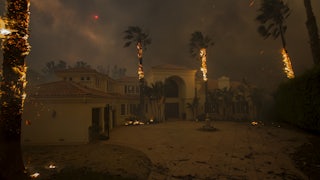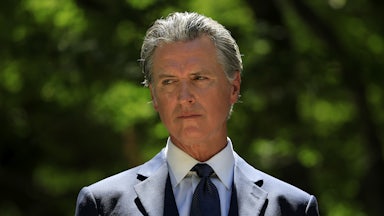Rain in Los Angeles ought to be cause for celebration. Rain—in a year of record drought and low snow, in December when December no longer means we’re safely out of fire season, after weeks of awful air quality—is a beautiful thing.
But the storm that blanketed Southern California in a gray wet wash on Monday, and the near-freezing temperatures that will follow later this week, are instead a harbinger of humanitarian disaster on city streets. Tens of thousands of unhoused people in Los Angeles County (66,000, at last count) suffered through the downpour and clammy cold. The city homeless services agency sent outreach teams to people camped in areas at risk of flooding, like rivers and canyons, and local activists and concerned neighbors fanned out to check on the tent encampments that have become a regular feature of almost the entirety of Los Angeles.
Each winter in L.A., people on the streets die from hypothermia—more than in New York or San Francisco. That’s after they survive the punishing heat of the summer and fall, and the air pollution, and violence: Despite regular scare campaigns and shoddy media coverage tying rising crime to homelessness (like a recent New York Times piece that put crime and homelessness rates in parallel), it remains the fact that unhoused people are often the victims of crime. A recent report by researchers at UCLA found that nearly 1,500 people died on the street in L.A. over the course of the pandemic.
The escalating homelessness crisis in Los Angeles has reached a fever pitch of “do something” energy—and that something has largely been new bans on camping. The county board of supervisors banned encampments in fire-prone areas in the outlying areas, and the city council outlawed sleeping, sitting, or lying down in 54 locations around the city. When it rains, it’s easy to see how these bans push people further from the places where they might seek a bit of dry ground or to warm up inside for a couple hours. Theo Henderson, host of the podcast We the Unhoused, pointed out to the Los Angeles Times that pandemic restrictions still in place prevent people from simply walking up to shelters, and that libraries or other public places where people might take refuge during the day don’t allow suitcases in; people would have to risk leaving their belongings on the street. The city is not supposed to enforce bans on tents or other makeshift shelters during rain or cold spells, but activists who monitor encampment sweeps (as I have in the past, as part of the organization Street Watch LA) know that the police and sanitation workers who show up for cleanups don’t always follow that rule.
The extra winter shelters on offer have a capacity of a few hundred. The bigger problem, in the long term, is that the shelters are often not safe, or interfere with people’s lives in other ways (curfews can be an issue for finding employment, and there may be restrictions like no pets or zero-tolerance drug policies). Most significantly, they rarely lead people in the direction of permanent housing, at least not on the scale that’s needed.
The most aggressively anti-homeless councilmembers say that the sweeps in their districts are accompanied by robust outreach to get people personalized help, but it’s far from clear whether shutting down the encampments is providing many people with long-term solutions to their housing woes. In October, six months after a high-profile, police-heavy clear-out of an encampment in the park at Echo Park Lake, The Guardian’s Sam Levin reported that only four of the 183 residents removed had been given permanent housing. Fewer than a third of the thousands of people who took advantage of Project Roomkey, a pandemic program that used federal funds to rent unused hotel rooms, had moved on to permanent housing when local radio station KCRW reported on it this summer. There is a sense among advocates that people are simply vanishing into thin air. “People are scattered and disappeared,” Ananya Roy, director of UCLA’s Institute on Inequality and Democracy, told Levin. “And there’s just a waning of what I call Covid compassion. We’re on the brink of a regime of pretty severe exclusion.”
Tiny homes, more shelters, and more hotel rooms have all been proposed (including by the candidates jostling to succeed Mayor Eric Garcetti, who is term-limited in 2022 and tapped by President Joe Biden be ambassador to India). None of these address the crisis of the lack of truly affordable housing in the city—and the state—which is why new people fall into homelessness each year.
All around the city, signs have gone up warning of “special enforcement zones,” where homeless people are not allowed to stay. As the rain cleared Monday afternoon, the straggling number of campers left in my neighborhood emerged to try to dry out their blankets and change into donated dry socks and sweatshirts. Cold is the first concern, then they worry about their belongings getting mold. “Inclement weather is the litmus test of the soul of our city,” Henderson told the LA Times. “You wanna see how compassionate we are, look at the policies we have that preclude poor people from surviving inclement weather.”








